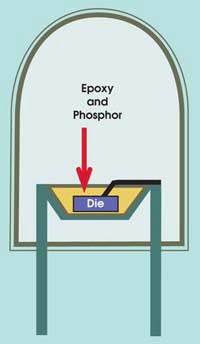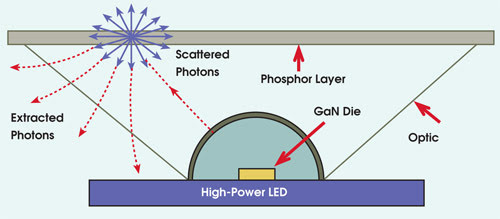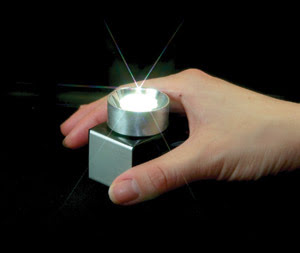A photon extraction technique reduces heat and removes photons more efficiently.
Nadarajah Narendran, Lighting Research Center at Rensselaer Polytechnic Institute
To be useful in lighting applications and to compete with traditional light sources, the white LED must show further increases in luminous efficacy and in the amount of light generated by a single device. Currently, commercial white LEDs are approaching 50 lm/W — a luminous efficacy two times greater than that produced just a couple of years ago. Most of this increase can be attributed to improvements made in light extraction from the die.
Phosphor is another component that needs improvement. Even though the phosphors currently used in white LEDs have high conversion efficiencies, the way they are placed within an LED package causes light loss. In most commercial phosphor-converted white LED packages, low or high power, the phosphor is usually dispersed within an epoxy resin that surrounds the blue die (Figure 1). When a phosphor particle absorbs energy from the die’s short-wavelength radiation, it releases longer-wavelength radiation uniformly in all directions. The mixture of short-wavelength radiation from the die and long-wavelength radiation from the phosphor creates white light.

Figure 1. In the traditional design of a 5-mm white LED, the phosphor is dispersed within the epoxy that surrounds the die — unfortunately, causing light loss.
The mix ratio of the short- and long-wavelength radiations determines the exact color of the final light. The amount of phosphor, or phosphor density, determines the amount of long-wavelength radiation emitted. Usually, manufacturers of white LEDs carefully select the density to achieve a chromaticity that falls on the blackbody locus. Earlier studies have found that the phosphor density affects the amount of light transmitted and reflected.
In studies at the Lighting Research Center at Rensselaer Polytechnic Institute in Troy, N.Y., we found that, with YAG:Ce phosphor at densities commonly used in white LEDs, more than 60 percent of the light emitted by the phosphor travels back toward the die.
In many cases, this light is absorbed and lost within the package, rather than escaping as visible light. Placing the phosphor adjacent to the die causes most of the backscattered light to be lost within the package. Other packaging designs since the late 1990s have proposed moving the phosphor away from the die. However, studies of the “remote phosphor” concept have not shown how to use the backscattered light to improve package efficiency.
Becoming the absorption of the backscattered photons is a source of significant light loss, we developed a concept called Scattered Photon Extraction, which is trademarked by the Lighting Research Center. With this technique, the phosphor is placed at a remote location from the die, and the optics between the die and the phosphor layer are shaped to efficiently extract the backscattered photons (Figure 2).

Figure 2. In the Scattered Photon Extraction white LED, the phosphor is situated away from the die. Optics between the die and the phosphor layer help extract photons backscattered by the phosphor, leading to greater light output and luminous efficacy. (Not drawn to scale.)
Experimental results showed a light output and efficacy increase of up to 60 percent compared with traditional white LED packages with the phosphor placed close to the die. The overall gain can be attributed to reduced heat on the phosphor particles — thus improving the conversion efficiency — and efficient extraction of backscattered photons from the phosphor layer.1
In a study in 2003, we showed that moving the phosphor away from the die not only increases flux and luminous efficacy, but also improves the useful life of the white LED. This improvement is due mostly to the reduced photodegradation of the epoxy adjacent to the die. Epoxy degradation is affected by the amount of heat from the die and the recirculation of short-wavelength radiation in the presence of phosphor particles near the die.
Moving the phosphor layer away from the die has the potential to increase the size of the light-emitting element within the package, even though it may not necessarily increase the overall LED package size (Figure 3). A larger source is not an issue for fixture optics used in general illumination; however, it could become an issue for some applications that require very small secondary optics to create narrow beam angles.

Figure 3. Phosphor placement is key to the efficiency achieved with this LED package based on Scattered Photon Extraction.
Subsequent to our demonstration of improved performance of white LEDs, other researchers have discussed alternative concepts for implementing remote phosphor in white LEDs. One of them, for example, showed an optical arrangement that gathers the short-wavelength radiation from the die and delivers it to a remote location where a phosphor layer of a similar size to the die is placed.
An advantage of this concept is that one can reap the benefits of the remote phosphor, including reduced heat and gathering of backscattered light, while at the same time preserving the small source size. Practical realization of such a package requires high precision in component placement during manufacture.
By combining the improvements in light extraction from the die with the remote phosphor concept, achieving the industry target of 150 lm/W by the year 2012 seems more promising.
Acknowledgments
This work was funded by a grant from the US Department of Energy (DE-FC26-01NT41203).
Meet the author
Nadarajah Narendran is an associate professor and director of research at the Lighting Research Center at Rensselaer Polytechnic Institute in Troy, N.Y.; e-mail: [email protected].
Reference
1. N. Narendran et al (May 2005). Extracting phosphor-scattered photons to improve white LED efficiency. PHYS STATUS SOLIDI A, pp. R60-R62.